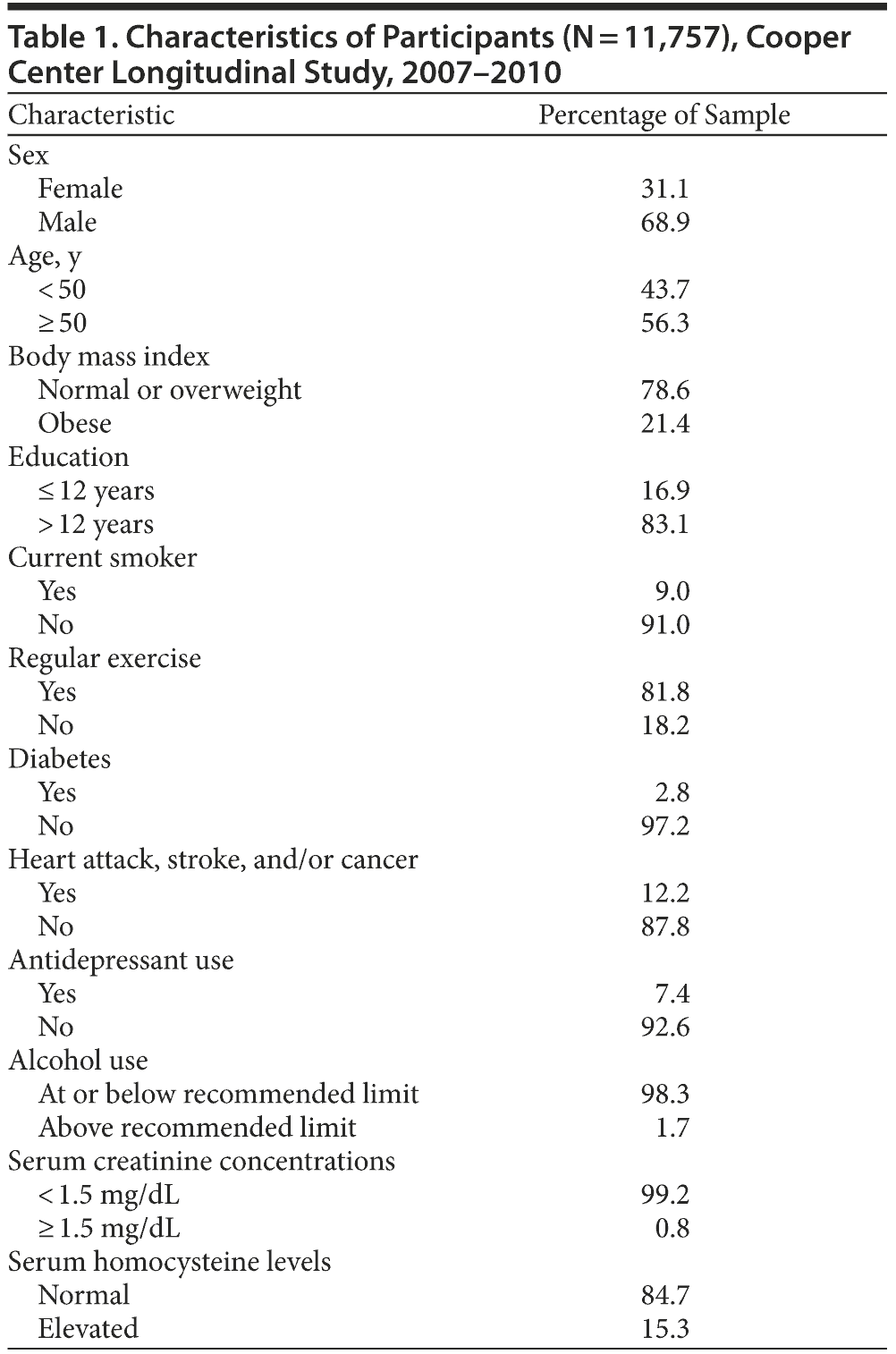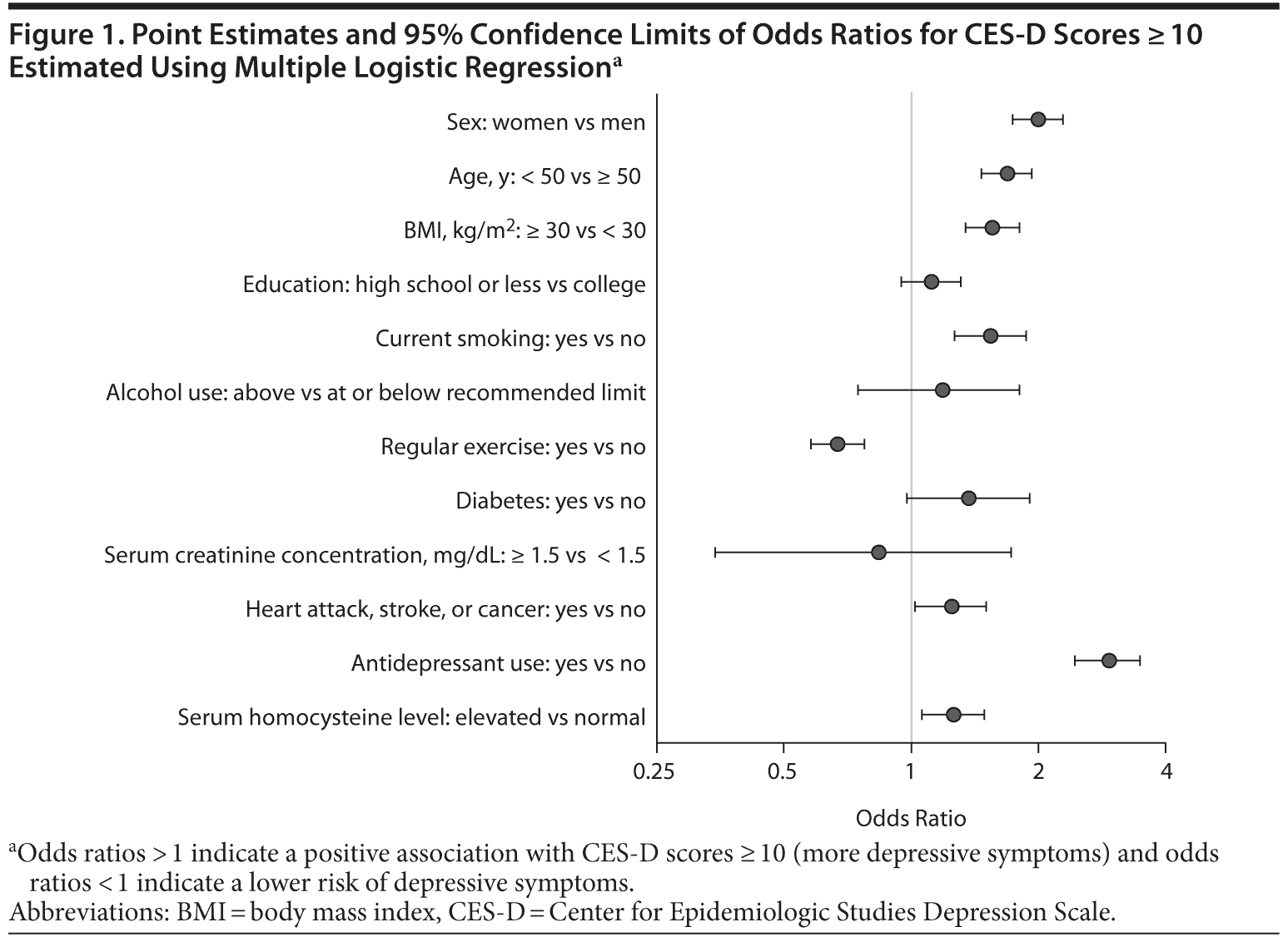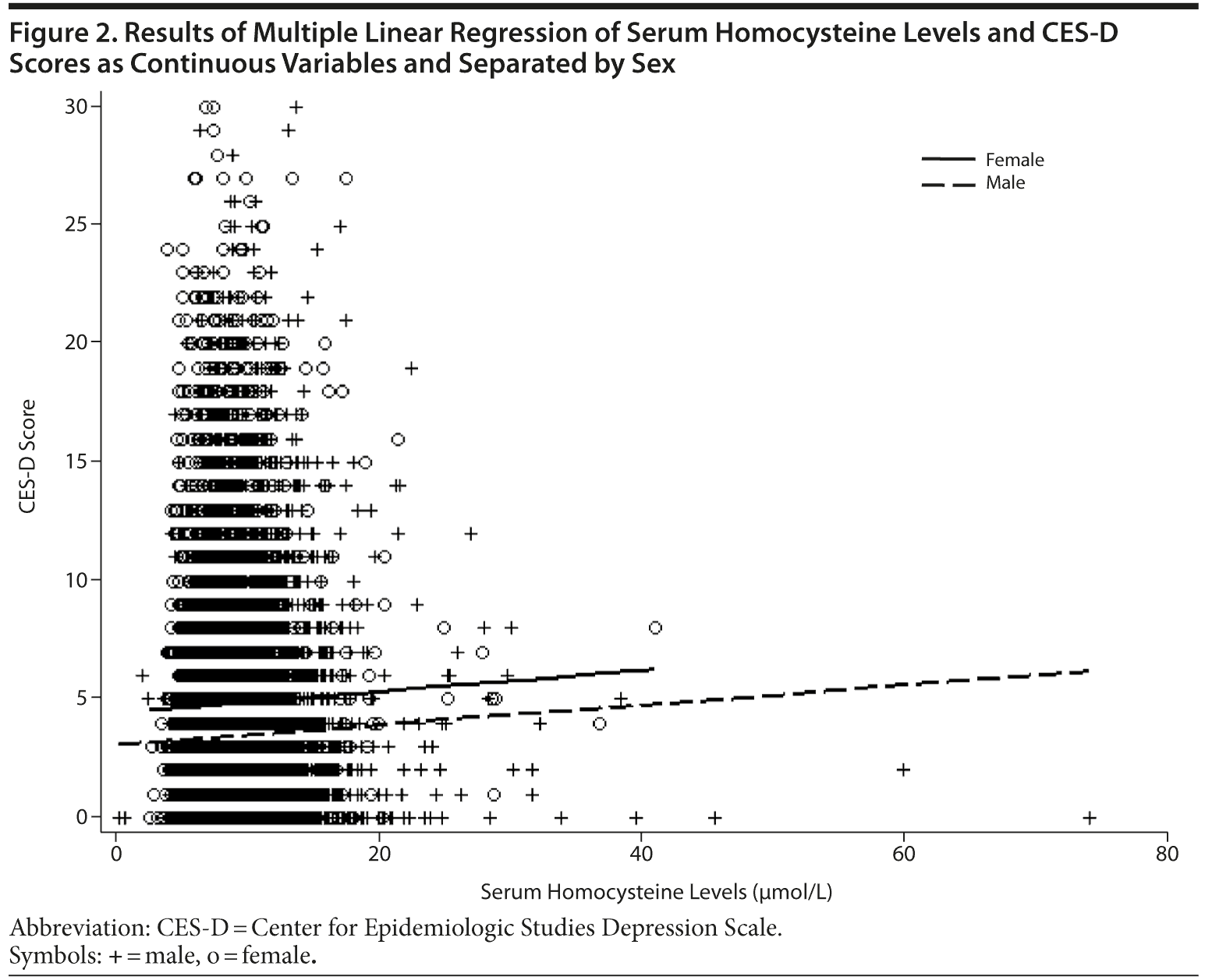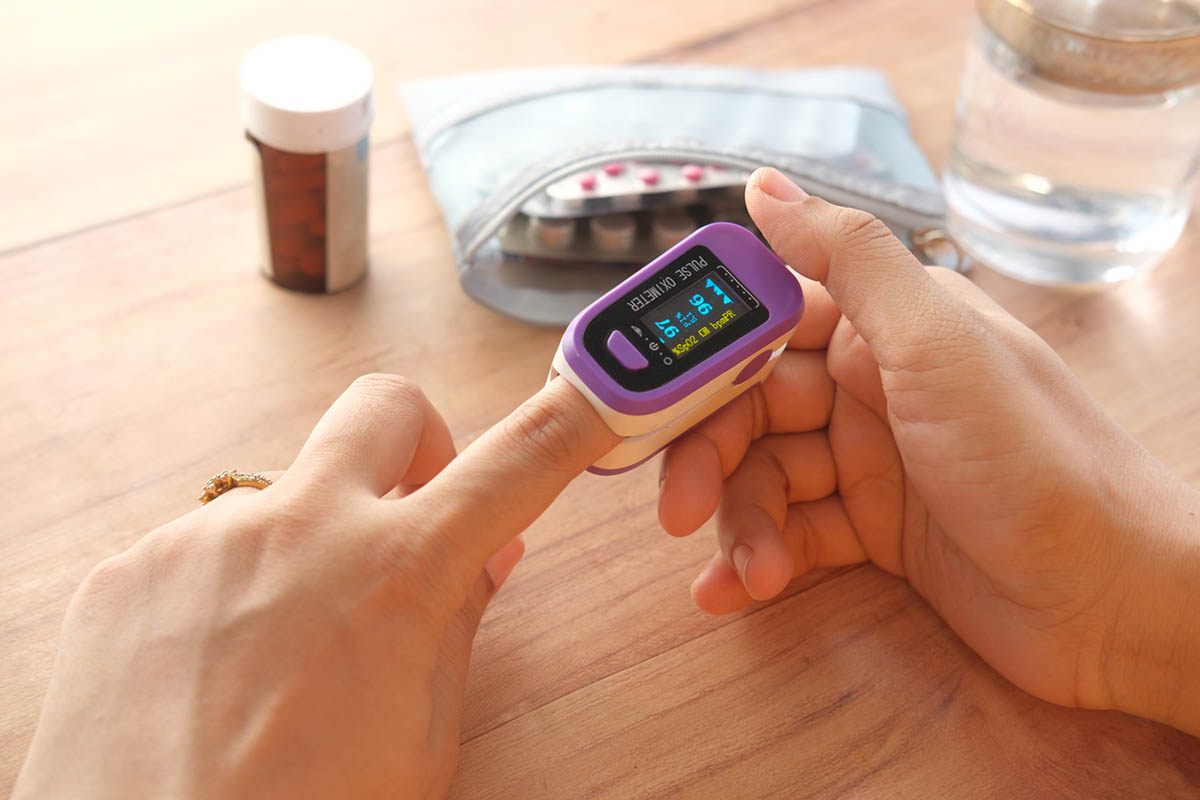Objective: Elevated serum levels of the amino acid homocysteine (HCY) are associated with a variety of diseases. To resolve conflicting findings in studies that suggest a relationship between elevated serum HCY levels and depression, we examined the relationship between HCY levels and depressive symptoms in the largest sample studied to date.
Method: We conducted a cross-sectional study of 11,757 participants (68.9% men) aged 20 to 90 years who completed preventive health examinations at the Cooper Clinic, Dallas, Texas, from 2007 to 2010. Currently experiencing depression was defined as a 10-item Center for Epidemiologic Studies Depression Scale (CES-D) score of ≥ 10. Serum HCY levels were obtained. Data were analyzed in a multiple logistic regression model of CES-D score of ≥ 10.
Results: When controlling for age, sex, body mass index, exercise, education, smoking, antidepressant use, creatinine level, alcohol use, and chronic medical conditions, elevated HCY was associated with 26% greater odds of currently experiencing depressive symptoms (P = .007) as defined by CES-D score.
Conclusions: In the largest sample examined to date, we found a significant positive relationship between elevated serum HCY levels and currently experiencing depressive symptoms. Given the cross-sectional nature of the study, it is not possible to determine the direction of the relationship or whether lowering HCY levels will ameliorate depressive symptoms. Thus, longitudinal studies are needed.
J Clin Psychiatry 2012; 73(5): 691-695
© Copyright 2012 Physicians Postgraduate Press, Inc.
Relationship Between Serum Homocysteine Levels and
Depressive Symptoms: The Cooper Center Longitudinal Study
ABSTRACT
Objective: Elevated serum levels of the amino acid homocysteine (HCY) are associated with a variety of diseases. To resolve conflicting findings in studies that suggest a relationship between elevated serum HCY levels and depression, we examined the relationship between HCY levels and depressive symptoms in the largest sample studied to date.
Method: We conducted a cross-sectional study of 11,757 participants (68.9% men) aged 20 to 90 years who completed preventive health examinations at the Cooper Clinic, Dallas, Texas, from 2007 to 2010. Currently experiencing depression was defined as a 10-item Center for Epidemiologic Studies Depression Scale (CES-D) score of ≥ 10. Serum HCY levels were obtained. Data were analyzed in a multiple logistic regression model of CES-D score of ≥ 10.
Results: When controlling for age, sex, body mass index, exercise, education, smoking, antidepressant use, creatinine level, alcohol use, and chronic medical conditions, elevated HCY was associated with 26% greater odds of currently experiencing depressive symptoms (P = .007) as defined by CES-D score.
Conclusions: In the largest sample examined to date, we found a significant positive relationship between elevated serum HCY levels and currently experiencing depressive symptoms. Given the cross-sectional nature of the study, it is not possible to determine the direction of the relationship or whether lowering HCY levels will ameliorate depressive symptoms. Thus, longitudinal studies are needed.
J Clin Psychiatry
© Copyright 2012 Physicians Postgraduate Press, Inc.
Submitted: June 20, 2011; accepted August 19. 2011.
Online ahead of print: March 20, 2012 (doi:10.4088/JCP.11m07223).
Corresponding author: E. Sherwood Brown, MD, PhD, Department of Psychiatry, University of Texas Southwestern Medical Center at Dallas, 5323 Harry Hines Blvd, MC 8849, Dallas, TX 75390-8849 ([email protected]).
Homocysteine (HCY) is a sulfur-containing amino acid derived from methionine through a series of demethylations.1 HCY can be remethylated to methionine by the methyltetrahydrofolate reductase (MTHFR) enzyme in the 5-methyltetrahydrofolate pathway, a process that requires vitamin B12 and folic acid.2 Thus, a deficiency of vitamin B12 and folic acid or poor absorption of vitamin B12 can result in elevated HCY levels. Genetic polymorphisms of the MTHFR enzyme, found in approximately 60% of the US population, are also associated with elevated HCY levels.1,3
Homocysteine has neurotoxic properties and may be associated with the development of disorders such as depression, seizures, Alzheimer’s disease, schizophrenia, and Parkinson’s disease.4–6 Although a mechanism for its neurotoxicity has not been established, several have been proposed. Homocysteine and its spontaneous oxidation product, homocysteic acid, may increase intracellular levels of ionized calcium and reactive oxygen species through binding to N-methyl-d-aspartate receptors, resulting in apoptosis.7 Homocysteine may hinder the biosynthesis of various neurotransmitters. In the 5-methyltetrahydrofolate cycle, S-adenosylmethionine (SAMe), a precursor for various neurotransmitters (serotonin, melatonin, epinephrine, and dopamine), is demethylated to become S-adenosylhomocysteine (SAH), then HCY, which is eventually converted back to SAMe.6 Under normal conditions, HCY is rapidly removed from cells to maintain a low concentration. However, the conversion of SAH to HCY is reversible via SAH-hydrolase, so when there is an increased intracellular concentration of HCY, the reaction favors SAH formation.8 High levels of HCY are associated with decreased levels of SAMe, which can result in the disruption in the biosynthesis of dopamine and serotonin; both are neurotransmitters associated with depression.1,9–13
To our knowledge, 15 studies examined the relationship between serum HCY and depression. Of these, 9 studies reported a significant association between elevated HCY levels and depression,2,13–20 and 6 did not.21–26 A meta-analysis of the available literature performed by Almeida et al2 suggested that elevated HCY levels are associated with depression. However, the available studies have some limitations. Many had modest sample sizes, included only one sex, and targeted senior citizens or were limited to medically ill populations. To elucidate the relationship between HCY and depression, we examined the serum HCY levels in the largest population to date and one that includes both sexes and a broad age range.
METHOD
Participants
The Cooper Center Longitudinal Study (CCLS) is a prospective follow-up of patients who have completed a preventive health examination at the Cooper Clinic in Dallas, Texas.27 The Cooper Clinic is a fee-for-service preventive medicine clinic. Records of 11,757 patients (3,652 women; 8,105 men) who were assessed between 2007 and 2010 and who completed baseline examinations that included serum HCY levels and a 10-item Center for Epidemiologic Studies Depression Scale (CES-D) were included. The overall Cooper Clinic evaluation includes a comprehensive medical history with physical activity variables, physical examination, and measurement of key biomarkers for chronic disease, including body mass index (BMI), blood pressure, lipoprotein profile, fasting blood glucose, and a maximal treadmill exercise test. Information in the current analysis included age, BMI, education level, smoking status, presence or absence of routine physical activity, antidepressant use, alcohol use, serum creatinine concentration, and history of diabetes, heart attack, stroke, and/or cancer as markers for general wellness and serious medical illness burden. The Cooper Clinic patients are generally college-educated and middle to upper income, and the vast majority (95%) are non-Hispanic white.
Participants gave informed consent for the use of their data, which were entered into the CCLS database maintained by the Cooper Institute. Privacy was maintained through the Cooper Institute policies. All data were deidentified prior to analysis. Data collection and informed consent are reviewed and approved annually by the Cooper Institute’s Institutional Review Board.
Assessments
Body mass index. Height and weight were measured utilizing a standard clinical scale and stadiometer. BMI was calculated as weight in kilograms divided by height in meters squared. A BMI of 20 to 25 kg/m2 was considered normal, a BMI of 25 to 30 kg/m2 was considered in the overweight range, and > 30 kg/m2 was obese.
Homocysteine. From January 2007 to February 2009, serum HCY was measured on a Dimension RXL Integrated Chemistry System (Siemens Healthcare Diagnostics Inc, Deerfield, Illinois) using the Carolina reagent (Carolina Liquid Chemistries Corp, Winston-Salem, North Carolina). After February 2009, an Ortho Vitros 5600 (Ortho Clinical Diagnostics, Johnson & Johnson, Rochester, New York) using the Ortho Clinical Diagnostics reagent (Ortho Clinical Diagnostics, Johnson & Johnson, Rochester, New York) was utilized. A method comparison was conducted between the Dimension and Vitros, and no significant difference was found (correlation coefficient of < 1.0) Bound HCY in the sample is reduced to free HCY by the action of dithiothreitol and then converted enzymatically to SAH. Conjugated S-adenosylcysteine (SAC), added at the onset of the reaction, competes with the SAH in the sample for bonding by anti-SAH antibodies bound to polystyrene particles. In the presence of SAH, there is either no aggregation or a weak aggregation of particles. In the absence of SAH in the sample, an aggregation of the polystyrene particles by the conjugated SAC occurs. The higher the SAH content of the reaction mixture, the smaller the scattered light signal. The result was evaluated by comparison with a standard of known concentration. Blood was drawn after an 8-hour fast in an 8.5 mL BD Vacutainer SST tube (BD, Franklin Lakes, New Jersey) between 7:00 and 9:00 am. Serum specimens were processed within 1 hour of the initial draw and not frozen. The HCY assay had a coefficient of variation of < 3.4% throughout the analytic range, which extended from 2.0 to 57.0 μmol/L. Male and female participants who were < 60 years and had HCY levels of ≥ 11.4 μmol/L and ≥ 10.4 μmol/L, respectively, were considered to have elevated HCY levels. Male and female participants who were ≥ 60 years and had HCY levels of ≥ 15.3 μmol/L and ≥ 11.6 μmol/L, respectively, were considered to have elevated HCY levels.28 Other studies have also used these values to define elevated homocysteine status.29–33 Vitamin B6, B12, and folate levels were not routinely obtained as part of this preventive examination but ordered as indicated clinically. Therefore, these biomarkers were not analyzed.
Depressive symptoms. The 10-item CES-D was used to quantify depressive symptoms during the previous week. This self-report scale assesses depressed mood, somatic retardation, and positive effect, generating a total severity score from 0 to 30, with a cutoff score of ≥ 10 indicating clinical depression.34 The CES-D is a well-studied and widely used screening instrument for symptoms of depressed mood, with good reliability and validity in detecting symptoms of depression.35 The 10-item CES-D has been tested in cross-cultural populations and has sensitivity and specificity comparable to the longer 20-item CES-D.34,35 Participants who had a score of ≥ 10 were referred to as currently having depressive symptoms.34
Statistical Methods
We used multiple logistic regression to predict CES-D score of ≥ 10 based on all the covariates presented in Table 1. We dichotomized age (dichotomized by ≥ 50 years), BMI (obese yes/no), education (dichotomized by ≤ 12 years of education), alcohol use (dichotomized by presence or absence of problem drinking defined as > 7 drinks/wk for women and > 14 drinks/wk for men),36,37 creatinine concentrations (dichotomized by ≥ 1.5 mg/dL, our laboratory’s normal range) because elevated HCY levels are associated with renal insufficiency,38,39 and HCY levels (elevated vs normal), as described previously, to construct clinically relevant odds ratios. We report profile-likelihood confidence intervals for all odds ratios (ORs). We also conducted a secondary analysis of HCY and CES-D scores as continuous variables using a multiple linear regression separated by sex, due to differences in CES-D scores in the men and women. We used SAS/STAT software version 9.2 (SAS Institute, Cary, North Carolina) for all analyses, including the summary statistics in Table 1.

RESULTS
Participant characteristics are shown in Table 1. A total of 3,652 women (31.1%) and 8,105 men (68.9%) participated in the study. Their mean (± SD) age was 51.7 (± 10.9) years. A majority of the participants (84.7%) had normal serum HCY levels, with a mean (± SD) level of 9.5 (2.8) μmol/L.
Serum HCY levels (OR = 1.26 [95% CI, 1.06–1.48]; [99% CI, 1.01–1.56]) were significantly associated with currently having depressive symptoms as defined by the CES-D. In addition, being < 50 years old (OR = 1.68 [95% CI, 1.48–1.92]), obese (OR = 1.56 [95% CI, 1.34–1.80]), female (OR = 1.99 [95% CI, 1.74–2.28]), a current smoker (OR = 1.54 [95% CI, 1.26–1.87]), and having a history of heart attack, stroke, or cancer (OR = 1.24 [95% CI, 1.02–1.50]) and using antidepressants (OR = 2.94 [95% CI, 2.46–3.49]) were significantly associated with currently experiencing depressive symptoms. Regular physical activity was associated with lower risk for currently having depressive symptoms (OR = 0.67 [95% CI, 0.58–0.78]). The profile-likelihood confidence limits for odds ratios are depicted in Figure 1. The area under the curve for the receiver operator characteristic curve was 0.68.

Results of a multiple linear regression separated by sex are in Figure 2. The linear regression model of CES-D scores on HCY levels, adjusted for the same additional covariates as the logistic regression model, explained R2 = 7.6% of the total variation of CES-D scores. The partial variations explained by these effects are antidepressant use (2.39%); sex (1.76%); age (1.07%); BMI (0.73%); physical activity (0.56%); current smoking (0.31%); HCY levels (0.05%); history of diabetes (0.04%); history of heart attack, stroke, or cancer (0.03%); education (0.02%); alcohol use (0.01%); and creatinine concentrations (0.00%). Homocysteine level was moderately correlated with age (r = 0.32 women, r = 0.19 men) and BMI (r = 0.16 women, r = 0.11 men), the 2 strongest predictors of CES-D scores after antidepressant use and sex.

DISCUSSION
The findings suggest a relationship between serum HCY levels and currently having depressive symptoms. Logistic regression analysis of the data using current CES-D scores of ≥ 10 showed that participants who had elevated HCY levels had 26% greater odds of currently experiencing depressive symptoms as defined by the CES-D. This finding is highly statistically significant, but the relationship between CES-D scores and serum HCY level was relatively modest and one of several factors, including sex, age, medical history, BMI, and tobacco use, related to an elevated risk of currently having depressive symptoms. The significant but relatively modest association in this large study between depressive symptoms and HCY levels may explain the discrepancies between previous studies, which had smaller samples and less statistical power. The only factor associated with a reduced risk of currently experiencing depressive symptoms was physical activity. This finding is consistent with prior reports from the Cooper Institute suggesting that physical activity and cardiorespiratory fitness are associated with lower rates of depression.40,41
Given the higher rates of depression in people with elevated HCY levels, this may be a clinical population to target for depression screening in primary care. Conversely, screening for elevated HCY levels in patients treated for depression may also be clinically useful. It is not known whether reducing HCY levels decreases depressive symptoms. The cross-sectional design of our study does not allow a determination of cause and effect. Two studies have suggested that folate supplementation, a common treatment for elevated HCY levels, may be an effective augmentation strategy for antidepressants.42,43 However, these studies had modest sample sizes and examined folate supplementation of selective serotonin reuptake inhibitors rather than as monotherapy. More research is needed to explore folate supplementation and other hyperhomocysteinemia treatments as antidepressant therapies.
The current study has several methodological limitations. The cohort has the limitation of small numbers of persons from minority racial or ethnic groups, making this analysis difficult to extrapolate to that population. Furthermore, because the Cooper Clinic is a fee-for-service preventive medicine clinic, the results may not be generalizable to lower-income populations. Although the study included 3,652 women, they represented only 31% of the sample; however, the analysis controlled for sex. The sample homogeneity may decrease the generalizability but increase the internal validity of the findings. In addition, the sample is diverse in terms of age range. Due to data collection methods, we did not use Diagnostic and Statistical Manual of Mental Disorders, Fourth Edition, criteria for diagnosing depression. The CES-D is designed primarily to assess depressive symptom severity and not to diagnose syndromal depression. However, it is a standard instrument for assessing depression in large studies, and standard cutoff scores have been established. It would have been useful to have had vitamin B6, B12, folate, SAMe, and MTHFR levels in addition to the HCY data; however, these data were not collected. Finally, a causal relationship could not be determined due to the cross-sectional design of the study. Depression could potentially be a cause rather than the effect of elevated HCY levels through dietary and lifestyle changes.
CONCLUSION
In a large sample of participants, elevated serum HCY levels were significantly associated with currently experiencing depressive symptoms. Longitudinal studies are needed to determine the direction of this relationship.
Author affiliations: Department of Psychiatry (Mr Gu, Ms John, and
Drs Weiner and Brown) and Department of Clinical Sciences (Dr Leonard), the University of Texas Southwestern Medical Center, Dallas; and the Cooper Institute (Dr DeFina), Dallas, Texas.
Potential conflicts of interest: The authors report no financial or other relationship relevant to the subject of this article.
Funding/support: Supported in part by the Science Teacher Access
to Resources at Southwestern program and The Cooper Institute.
REFERENCES
1. Li S, Arning E, Liu C, et al. Regulation of homocysteine homeostasis through the transcriptional coactivator PGC-1alpha. Am J Physiol Endocrinol Metab. 2009;296(3):E543–E548. doi:10.1152/ajpendo.90719.2008 PubMed
2. Almeida OP, McCaul K, Hankey GJ, et al. Homocysteine and depression
in later life. Arch Gen Psychiatry. 2008;65(11):1286–1294. doi:10.1001/archpsyc.65.11.1286 PubMed
3. Sontag E, Nunbhakdi-Craig V, Sontag JM, et al. Protein phosphatase 2A methyltransferase links homocysteine metabolism with tau and amyloid precursor protein regulation. J Neurosci. 2007;27(11):2751–2759. doi:10.1523/JNEUROSCI.3316-06.2007 PubMed
4. Mattson MP, Shea TB. Folate and homocysteine metabolism in neural plasticity and neurodegenerative disorders. Trends Neurosci. 2003;26(3):
137–146. doi:10.1016/S0166-2236(03)00032-8 PubMed
5. Quinn CT, Griener JC, Bottiglieri T, et al. Methotrexate, homocysteine,
and seizures. J Clin Oncol. 1998;16(1):393–394. PubMed
6. Miller AL. The methylation, neurotransmitter, and antioxidant connections between folate and depression. Altern Med Rev. 2008;13(3):216–226. PubMed
7. Boldyrev AA. Molecular mechanisms of homocysteine toxicity. Biochemistry (Mosc). 2009;74(6):589–598. doi:10.1134/S0006297909060017 PubMed
8. Papakostas GI, Petersen T, Lebowitz BD, et al. The relationship between serum folate, vitamin B12, and homocysteine levels in major depressive disorder and the timing of improvement with fluoxetine. Int J Neuropsychopharmacol. 2005;8(4):523–528. doi:10.1017/S1461145705005195 PubMed
9. Bottiglieri T, Godfrey P, Flynn T, et al. Cerebrospinal fluid S-adenosylmethionine in depression and dementia: effects of treatment with parenteral and oral S-adenosylmethionine. J Neurol Neurosurg Psychiatry. 1990;53(12):1096–1098. doi:10.1136/jnnp.53.12.1096 PubMed
10. aan het Rot M, Mathew SJ, Charney DS. Neurobiological mechanisms in major depressive disorder. CMAJ. 2009;180(3):305–313. doi:10.1503/cmaj.080697 PubMed
11. Fuso A, Nicolia V, Cavallaro RA, et al. B-vitamin deprivation induces hyperhomocysteinemia and brain S-adenosylhomocysteine, depletes
brain S-adenosylmethionine, and enhances PS1 and BACE expression and amyloid-beta deposition in mice. Mol Cell Neurosci. 2008;37(4):731–746. doi:10.1016/j.mcn.2007.12.018 PubMed
12. Waldmeier PC, Feldtrauer JJ. On the role of O-methylation in the metabolism of S-adenosylmethionine in rat brain. Biochem Pharmacol. 1987;36(17):2855–2861. doi:10.1016/0006-2952(87)90276-0 PubMed
13. Bottiglieri T, Laundy M, Crellin R, et al. Homocysteine, folate, methylation, and monoamine metabolism in depression. J Neurol Neurosurg Psychiatry. 2000;69(2):228–232. doi:10.1136/jnnp.69.2.228 PubMed
14. Dimopoulos N, Piperi C, Salonicioti A, et al. Correlation of folate, vitamin B12 and homocysteine plasma levels with depression in an elderly Greek population. Clin Biochem. 2007;40(9–10):604–608. doi:10.1016/j.clinbiochem.2007.01.007 PubMed
15. Bjelland I, Tell GS, Vollset SE, et al. Folate, vitamin B12, homocysteine,
and the MTHFR 677C->T polymorphism in anxiety and depression: the Hordaland Homocysteine Study. Arch Gen Psychiatry. 2003;60(6):618–626. doi:10.1001/archpsyc.60.6.618 PubMed
16. Ramos MI, Allen LH, Haan MN, et al. Plasma folate concentrations are associated with depressive symptoms in elderly Latina women despite folic acid fortification. Am J Clin Nutr. 2004;80(4):1024–1028. PubMed
17. Tolmunen T, Hintikka J, Voutilainen S, et al. Association between depressive symptoms and serum concentrations of homocysteine in men:
a population study. Am J Clin Nutr. 2004;80(6):1574–1578. PubMed
18. Chen CS, Tsai JC, Tsang HY, et al. Homocysteine levels, MTHFR C677T genotype, and MRI hyperintensities in late-onset major depressive disorder. Am J Geriatr Psychiatry. 2005;13(10):869–875. PubMed
19. Forti P, Rietti E, Pisacane N, et al. Blood homocysteine and risk of depression in the elderly. Arch Gerontol Geriatr. 2010;51(1):21–25. doi:10.1016/j.archger.2009.06.009 PubMed
20. Nanri A, Mizoue T, Matsushita Y, et al. Serum folate and homocysteine and depressive symptoms among Japanese men and women. Eur J Clin Nutr. 2010;64(3):289–296. doi:10.1038/ejcn.2009.143 PubMed
21. Penninx BW, Guralnik JM, Ferrucci L, et al. Vitamin B(12) deficiency
and depression in physically disabled older women: epidemiologic evidence from the Women’s Health and Aging Study. Am J Psychiatry. 2000;157(5):715–721. doi:10.1176/appi.ajp.157.5.715 PubMed
22. Tiemeier H, van Tuijl HR, Hofman A, et al. Vitamin B12, folate, and homocysteine in depression: the Rotterdam Study. Am J Psychiatry. 2002;159(12):2099–2101. doi:10.1176/appi.ajp.159.12.2099 PubMed
23. Robinson D, O’Luanaigh C, Tehee E, et al. Associations between holotranscobalamin, vitamin B12, homocysteine and depressive
symptoms in community-dwelling elders. Int J Geriatr Psychiatry. 2011;26(3):307–313. PubMed
24. Fava M, Borus JS, Alpert JE, et al. Folate, vitamin B12, and homocysteine in major depressive disorder. Am J Psychiatry. 1997;154(3):426–428. PubMed
25. Morris MS, Fava M, Jacques PF, et al. Depression and folate status in
the US Population. Psychother Psychosom. 2003;72(2):80–87. doi:10.1159/000068692 PubMed
26. Kamphuis MH, Geerlings MI, Grobbee DE, et al. Dietary intake of
B(6-9-12) vitamins, serum homocysteine levels and their association
with depressive symptoms: the Zutphen Elderly Study. Eur J Clin Nutr. 2008;62(8):939–945. doi:10.1038/sj.ejcn.1602804 PubMed
27. Blair SN, Kohl HW III, Paffenbarger RS, Jr, et al. Physical fitness and
all-cause mortality: a prospective study of healthy men and women.
JAMA. 1989;262(17):2395–2401. PubMed
28. Selhub J, Jacques PF, Rosenberg IH, et al. Serum total homocysteine concentrations in the third National Health and Nutrition Examination Survey (1991–1994): population reference ranges and contribution of vitamin status to high serum concentrations. Ann Intern Med. 1999;
131(5):331–339. PubMed
29. Janson JJ, Galarza CR, Murúa A, et al. Prevalence of hyperhomocysteinemia in an elderly population. Am J Hypertens. 2002;15(5):394–397. doi:10.1016/S0895-7061(01)02165-3 PubMed
30. Pilsner JR, Liu X, Ahsan H, et al. Folate deficiency,
hyperhomocysteinemia, low urinary creatinine, and
hypomethylation of leukocyte DNA are risk factors for arsenic-
induced skin lesions. Environ Health Perspect. 2009;117(2):254–260. PubMed
31. Gamble MV, Ahsan H, Liu X, et al. Folate and cobalamin deficiencies
and hyperhomocysteinemia in Bangladesh. Am J Clin Nutr. 2005;81(6):
1372–1377. PubMed
32. Schroecksnadel K, Leblhuber F, Frick B, et al. Association of hyperhomocysteinemia in Alzheimer disease with elevated neopterin levels. Alzheimer Dis Assoc Disord. 2004;18(3):129–133. doi:10.1097/01.wad.0000127443.23312.31 PubMed
33. Schroecksnadel K, Frick B, Kaser S, et al. Moderate hyperhomocysteinaemia and immune activation in patients with rheumatoid arthritis. Clin Chim Acta. 2003;338(1–2):157–164. doi:10.1016/j.cccn.2003.09.003 PubMed
34. Lue BH, Chen LJ, Wu SC. Health, financial stresses, and life satisfaction affecting late-life depression among older adults: a nationwide, longitudinal survey in Taiwan. Arch Gerontol Geriatr. 2010;
50(suppl 1):S34–S38. doi:10.1016/S0167-4943(10)70010-8 PubMed
35. Andresen EM, Malmgren JA, Carter WB, et al. Screening for depression
in well older adults: evaluation of a short form of the CES-D (Center for Epidemiologic Studies Depression Scale). Am J Prev Med. 1994;10(2):
77–84. PubMed
36. Manwell LB, Fleming MF, Johnson K, et al. Tobacco, alcohol, and drug
use in a primary care sample: 90-day prevalence and associated factors. J Addict Dis. 1998;17(1):67–81. doi:10.1300/J069v17n01_07 PubMed
37. National Institute on Alcohol Abuse and Alcoholism. The Physician’s
Guide to Helping Patients with Alcohol Problems. Bethesda, MD: National Institute on Alcohol Abuse and Alcoholism; 1995. NIH Publication No. 95-3769.
38. Samuelsson O, Lee DM, Attman PO, et al. The plasma levels of homocysteine are elevated in moderate renal insufficiency but do
not predict the rate of progression. Nephron. 1999;82(4):306–311. doi:10.1159/000045445 PubMed
39. Sarnak MJ, Wang SR, Beck GJ, et al. Homocysteine, cysteine,
and B vitamins as predictors of kidney disease progression. doi:10.1053/ajkd.2002.36323 PubMed
40. Sui X, Hooker SP, Lee IM, et al. A prospective study of cardiorespiratory fitness and risk of type 2 diabetes in women. Diabetes Care. 2008;31(3):
550–555. doi:10.2337/dc07-1870 PubMed
41. Galper DI, Trivedi MH, Barlow CE, et al. Inverse association between physical inactivity and mental health in men and women. Med Sci Sports Exerc. 2006;38(1):173–178. doi:10.1249/01.mss.0000180883.32116.28 PubMed
42. Coppen A, Bailey J. Enhancement of the antidepressant action of fluoxetine by folic acid: a randomised, placebo controlled trial. J Affect Disord. 2000;60(2):121–130. doi:10.1016/S0165-0327(00)00153-1 PubMed
43. Alpert JE, Mischoulon D, Rubenstein GE, et al. Folinic acid (Leucovorin) as an adjunctive treatment for SSRI-refractory depression. Ann Clin Psychiatry. 2002;14(1):33–38. doi:10.3109/10401230209147396 PubMed
Author Affiliations

Enjoy free PDF downloads as part of your membership!
Save
Cite



